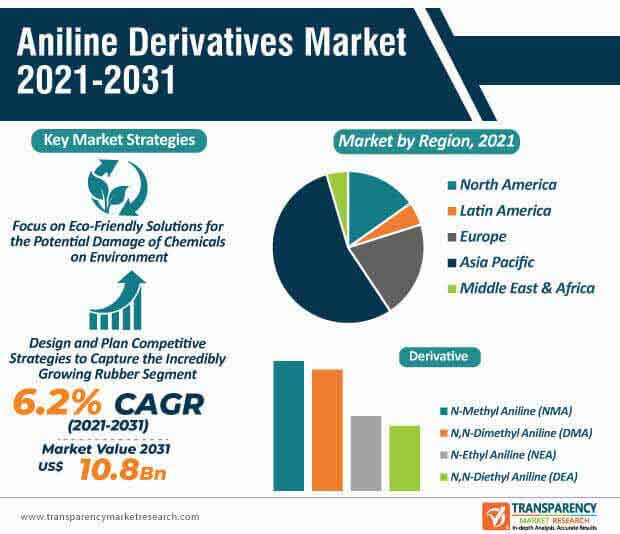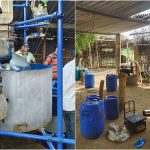
Market Outlook: A Deep Dive into the Global N-Methyl Aniline Industry
The global N-Methyl Aniline market has become a key topic among investors, manufacturers, and industry watchers alike, as it steadily transforms into a critical component for various manufacturing sectors. With an estimated value surge from USD 1.4 billion in 2024 to around USD 2.6 billion by 2034 and a projected CAGR of 6.2% over the forecast period, the industry is showcasing promising potential for growth. In this opinion editorial, we take a closer look into the market trends, funding initiatives, and regional dynamics that are shaping the industry’s future while addressing some of the tricky parts and tangled issues that come hand in hand with chemical innovation.
Unraveling the Product Form Dynamics
One of the key factors driving the debate in the N-Methyl Aniline market is the distinct advantages offered by various product forms. In 2024, the liquid form dominated the market, holding an impressive 87.4% share. Widely used as an intermediate in agrochemical formulations, dye production, and numerous industrial chemical syntheses, liquid N-Methyl Aniline stands out because of its superior solubility, stability, and ease of handling. Such features not only allow manufacturers to get around many of the confusing bits in production processes but also help maintain operational efficiency during large-scale production.
Liquid Versus Solid: What Sets Them Apart?
The distinction between liquid and solid forms of N-Methyl Aniline goes beyond mere physical state—they represent different operational benefits and usage paradigms in industrial settings. The liquid form, for instance, is heavily favored for its adaptability. Here are some of the fine points that differentiate the two:
- Liquid Form: Offers better solubility and is easier to integrate into production lines, making it a must-have for high-volume manufacturing.
- Solid Form: Although less prevalent, it is sometimes used in applications where storage stability is a major concern.
- Handling and Storage: The liquid form’s handling simplicity often leads companies to prefer it, reducing the nerve-racking and intimidating complexities associated with solids.
Application Insights: The Dominance of Dyes and Pigments
Among various applications, the use of N-Methyl Aniline in dyes and pigments has captured a significant portion of the market share—about 34.5% in 2024. Industry insiders point to the compound’s invaluable role in synthesizing synthetic dyes and colorants for textiles, coatings, and printing inks. The compound’s ability to enhance color stability and performance is a key driver that has industries steadily pushing production capacities higher.
Industrial Applications and Their Impact
When we dig into the specifics of its application in dyes and pigments, several aspects become evident:
- Enhancing Color Performance: Manufacturers rely on N-Methyl Aniline to boost the vibrancy and durability of colors—small distinctions in formulation can lead to significant improvements in end-product quality.
- Broad Industry Use: The compound is a critical ingredient not only in the fashion and textile sectors but also in the production of high-quality coatings and printing inks.
- Innovative Manufacturing: Continuous innovation in dye synthesis, such as the development of cleaner, more sustainable approaches, is gradually replacing more conventional methods while still relying on the key benefits provided by N-Methyl Aniline.
Driving Forces Behind Market Expansion
One cannot ignore the myriad of driving factors pushing the global N-Methyl Aniline market toward growth. The rising demand for specialty chemicals and bio-based pigments across industrial sectors is a prime catalyst. As manufacturers embrace eco-friendly production methods, the compound’s role as an intermediate in producing next-generation agrochemicals has gained further momentum.
Key Drivers Fueling Industrial Growth
There are several intertwined driving forces responsible for the market’s upward trend. Here, we outline the factors contributing to this expansion:
| Factor | Impact |
|---|---|
| Rising Demand for Specialty Chemicals | Increased use in the formulation of herbicides, dyes, and new agrochemical products |
| Funding and Investment Trends | More capital flowing into agrochemical and specialty chemical sectors, boosting production capacities |
| Technological Advancements | Innovation in production methods and eco-friendly synthesis techniques |
| Global Industrial Expansion | Broader application scope in developed and emerging markets, especially in North America and Asia Pacific |
Challenges Along the Way: Dealing with Environmental Regulations
Like many sectors in the chemical industry, the N-Methyl Aniline market is not without its challenges. Stringent environmental and safety regulations have posed several intimidating and overwhelming hurdles that companies must overcome. The production and handling of aromatic amines often involve dealing with scary and off-putting compliance issues, which may include rigorous waste disposal methods and emission standards designed to protect the environment.
Tangled Issues and Regulatory Compliance
The industry’s compliance landscape is often riddled with tension and is loaded with issues that require delicate handling. Here are some of the major concerns:
- Strict Emission Standards: Manufacturers need to meet high environmental benchmarks, which could lead to increased production costs.
- Waste Disposal Challenges: Proper disposal methods must be followed to avoid environmental hazards, a process fraught with nerve-racking procedural twists and turns.
- Transition to Greener Alternatives: The gradual shift towards bio-based solutions means that traditional chemical intermediates may face stiff competition from more sustainable counterparts.
Growth Opportunities in Sustainable Pigments and Coatings
A major opportunity lying ahead for the N-Methyl Aniline market is its expanding role in sustainable pigments and coatings. As many industries pivot towards eco-friendly colorants and cleaner production processes, the demand for reliable chemical intermediates—ones that enable the manufacture of these modern products—is increasing.
Capitalizing on Eco-Friendly Innovations
Efforts to transition to greener chemical production systems present an exciting frontier. The innovative use of N-Methyl Aniline in renewable pigment reforms is opening new avenues. Some noteworthy aspects include:
- Clean Production Processes: Investment in cleaner chemical synthesis methods is reducing the environmental impact of pigment manufacture.
- Sustainable Agrochemical Production: The compound contributes to more sustainable herbicide and agrochemical designs that reduce chemical waste.
- Investor Interest: Funding initiatives, such as recent investments by startups focused on sustainable AgTech, reinforce market confidence in eco-friendly production practices.
Emerging Trends in Eco-Friendly Dye Production
A notable trend in the market is the growing shift toward sustainable dye production. With a global emphasis on minimizing chemical waste and lowering carbon footprints, manufacturers are beginning to embrace innovative, greener dye technologies. Such trends not only improve the sustainability profile of chemical production but also introduce opportunities for the incorporation of N-Methyl Aniline as a key component in next-generation formulations.
Green Chemistry in the Modern Industrial Landscape
The landscape is evolving, with a noticeable move towards eco-friendly practices among dye manufacturers. Recent funding successes, including investments worth millions of dollars in sustainable dye technologies, underscore this shift. Manufacturers are now tapping into:
- Renewable Feedstocks: The use of renewable materials in dye synthesis is a growing trend, helping to lower environmental impact.
- Low-Impact Production Methods: Cleaner production techniques that reduce hazardous waste are gaining popularity and supporting the adoption of N-Methyl Aniline in greener formulations.
- Innovative Start-Ups: New players in the market are quickly adapting to green chemistry innovations, which inject fresh energy into traditional sectors and offer opportunities to reengineer dye formulations.
Regional Dynamics: North America, Europe, and Beyond
Geographically, the market exhibits distinct patterns across regions. In 2024, North America held 44.90% of the market share with a value of about USD 0.6 billion. This strong performance reflects the region’s robust industrial chemical infrastructure, growing agrochemical production, and continuous demand from dye and pigment manufacturers. Meanwhile, Europe and the Asia Pacific region have also shown steady growth, each contributing their own set of opportunities and challenges.
Comparing Regional Market Performances
When we dig into the regional disparities in market performance, several factors become apparent:
- North America:
- Strong industrial base and advanced processing technologies
- Supportive regulatory frameworks easing the production process
- Robust agrochemical and specialty chemical sectors
- Europe:
- Focus on sustainable chemical synthesis
- Resilient specialty chemical manufacturing with an emphasis on greener alternatives
- Asia Pacific:
- Rapidly expanding manufacturing bases
- Increasing foreign investments in industrial chemicals
- Emerging middle-class economies fueling higher demand
- Latin America and Middle East & Africa:
- Moderate growth driven by agricultural sector expansion
- Growing industrial diversification leading to broader adoption of chemical intermediates
Funding Initiatives: Injecting Vital Capital into the Sector
Investment and funding have become an essential part of the narrative surrounding the N-Methyl Aniline market. Several recent financial initiatives underscore strong market confidence. Companies like Arbuda Agrochemicals and Kotak arm have invested hundreds of crores to fuel expansion—a move that not only supports the production of intermediates like N-Methyl Aniline but also enables the broader agrochemical and specialty chemical industries to flourish.
Key Funding Milestones and Their Implications
There is no denying that financial backing plays a super important role in modern industrial manufacturing. Recent transactions and funding initiatives have had notable repercussions:
- Initiatives such as the NSE Emerge IPO by Arbuda Agrochemicals, valued at ₹120 crore, are aimed at debt reduction and product line expansion.
- An infusion of approximately Rs 375 crore by Kotak arm into an agrochemical firm highlights the growing capital flow in the chemical manufacturing landscape.
- Investments in innovation and green chemistry—evident by startups like Scimplify and VitalFluid raising significant funds—are paving the way for next-generation advancements.
Operational Efficiency: Key Players Shaping the Market
Established and emerging companies alike are playing critical roles in driving the global N-Methyl Aniline market. Leading players such as AARTI Finetech Industry Limited, Hefei TNJ Chemical Industry Co., Ltd., Changzhou Baolong Chemicals Co., Ltd., and Hangzhou Dayangchem Co., Limited have built reputations for quality and innovation. Their strategic focus on customized chemical synthesis, stringent safety standards, and upgrading production capabilities has allowed them to remain competitive in a market full of confusing bits and operational twists.
Profiles of Industry Leaders
Here’s an outline of some of the top companies and how they contribute to market development:
- AARTI Finetech Industry Limited: Known for its consistent quality improvements and customized chemical synthesis, the company is a reliable partner for global clients.
- Hefei TNJ Chemical Industry Co., Ltd.: With an integrated production capability, this company focuses heavily on safety and environmental standards, positioning itself as a leader in both traditional and eco-friendly solutions.
- Changzhou Baolong Chemicals Co., Ltd.: This firm is recognized for its cost-effective production techniques, ensuring a steady supply of high-purity intermediates to meet expanding industry demands.
- Hangzhou Dayangchem Co., Limited: Continuously investing in technology upgrades, they have carved out a niche for themselves in the sector by meeting increasingly demanding industry standards.
Weighing the Economic Implications and Market Trends
Market assessments suggest that the growth of the N-Methyl Aniline sector is interconnected with broader industrial trends such as the expansion of agrochemical production, the rising need for specialty chemicals, and the global pivot to sustainable manufacturing. The industry’s evolution, however, is accompanied by a range of tricky parts that require manufacturers to steer through both regulatory measures and shifting consumer trends in efficiency and eco-friendliness.
Tackling the Twists and Turns of Market Demand
Understanding the market dynamics requires figuring a path through several layers of operational and economic complexities. Here are some of the main aspects industry players and financial observers need to consider:
- Adaptation to New Regulations: Companies must continuously innovate to comply with evolving environmental guidelines while still keeping production costs manageable.
- Market Size and Expansion: With a forecasted market value increase to USD 2.6 billion by 2034, scaling production while maintaining quality standards is a balancing act.
- Investment in Advanced Production Technologies: Adoption of advanced manufacturing technologies can help reduce the intimidating operational hurdles linked to chemical production and ensure sustained growth.
Environmental Considerations: A Balancing Act for Modern Manufacturers
Manufacturers face the nerve-racking challenge of meeting stringent environmental standards while still pushing forward with production demands. The production of aromatic amines, including N-Methyl Aniline, naturally presents complicated pieces that require precise waste management and emission control strategies. Companies must find the right balance between maintaining their competitive edge and ensuring sustainable, low-impact operations.
Strategies for Balancing Production and Environmental Safety
Several approaches have proven useful for companies striving to meet tough regulatory standards:
- Implementing Advanced Monitoring Systems: Technologies that continuously track emissions and waste levels can help manufacturers reduce the risk of compliance issues.
- Upgrading Production Infrastructure: Investments in modern, efficient production facilities enable companies to produce high-quality N-Methyl Aniline with reduced environmental impact.
- Research and Development Initiatives: Increasing R&D efforts into alternative synthesis methods is essential for finding more sustainable production pathways.
Opportunities in Industrial Manufacturing and Beyond
While the market faces its share of challenges and off-putting regulatory twists and turns, there is significant potential in tapping into new applications for N-Methyl Aniline. Its role in the manufacturing of high-energy performance coatings, specialty chemicals used in pharmaceuticals, and even components for automotive systems indicates that its utility stretches well beyond traditional applications.
Expanding Horizons: Beyond Agrochemicals and Dyes
Looking ahead, companies and investors are starting to explore how N-Methyl Aniline can be integrated into various emerging industries:
- Automotive Applications: With the shift toward electric vehicles, chemical intermediates are finding a place in advanced coatings and specialty components.
- Healthcare and Pharmaceuticals: The compound’s use in pharmaceutical synthesis, including intermediaries required for drug production, is gaining recognition.
- Industrial Manufacturing Upgrades: As industries modernize, the demand for high-performance and stable chemical solutions will likely push the adoption of N-Methyl Aniline into newer sectors.
Industry Perspectives: A Neutral Analysis on Future Prospects
Evaluating the global N-Methyl Aniline market from a big-picture stance, one notices that the many facets of this sector are both promising and peppered with challenges. Large-scale investments, shifting environmental policies, and evolving consumer preferences collectively form a scenario that demands continuous adjustment and operational finesse. While the market is walking through a maze of conflicting demands, most industry experts agree that the overall trajectory remains positive.
Key Considerations for Future Growth
To summarize, here are several critical areas that will guide the future direction of the market:
- Advancement in Production Technology: Upgrading manufacturing plants to be both efficient and eco-friendly is a central theme for industry leaders.
- Compliance and Environmental Strategies: Businesses must continually find their way through the maze of strict environmental regulations while keeping costs manageable.
- Market Diversification: Expanding into emerging sectors such as automotive systems, healthcare applications, and advanced industrial manufacturing will broaden the compound’s utility and market potential.
- Investment in R&D: Research initiatives focusing on greener synthesis methods and efficient production techniques promise to open doors for sustainable growth in the long run.
Concluding Thoughts: Charting a Steady Course in a Dynamic Market
In conclusion, the global N-Methyl Aniline market is set on an adventurous path that mirrors the broader evolution of industrial manufacturing and specialty chemicals worldwide. As the market expands from a value of USD 1.4 billion in 2024 to a projected USD 2.6 billion by 2034, the role of key applications such as dyes, pigments, and agrochemical intermediates remains super important. While companies must carefully manage the complicated pieces of production and adhere to rigorous environmental standards, the potential benefits of innovation, financial backing, and regional expansion make for a compelling industry narrative.
Looking Ahead: Embracing Innovation and Sustainability
As we take a closer look at the evolving dynamics of the market, one sees a scene brimming with both opportunities and challenges. Stakeholders are encouraged to continue investing in advanced technological solutions, explore greener alternatives, and maintain a clear focus on operational efficiency. This balanced approach can help industry players figure a path through the complex twists and turns of market demand while fostering sustainable growth that benefits both economic prospects and environmental stewardship.
Final Reflections
From the steady financial inflows to the groundbreaking advancements in production technology and the relentless shift toward sustainability, the journey of the N-Methyl Aniline market is one marked by both exciting opportunities and nerve-racking challenges. Industry participants must dig into the nitty-gritty details, plan for unexpected regulatory twists, and invest prudently in research and development to stay ahead in a market loaded with issues. With a focus on eco-friendly innovations and the smart allocation of capital, the future of N-Methyl Aniline looks promising—paving the way for a new era in industrial manufacturing, chemicals, and specialty applications.
Key Takeaways in Brief
To encapsulate, here are the main points to remember:
- The global N-Methyl Aniline market is witnessing robust growth with a projected value escalation to USD 2.6 billion by 2034.
- The liquid form remains the preferred choice due to its superior handling characteristics and efficiency in production processes.
- Applications in dyes, pigments, and agrochemicals continue to drive significant market demand.
- Strict environmental standards and regulatory challenges are among the more overwhelming aspects, yet companies are adapting through innovation and advanced technological investments.
- Regional trends highlight North America’s dominant position, with Europe and Asia Pacific also making significant contributions.
- Future opportunities lie in embracing sustainable practices that integrate green chemistry into mainstream production.
Final Word
The ongoing evolution of the N-Methyl Aniline market teaches us that while industrial manufacturing may often be full of problems and tangled issues, the opportunities for growth and innovation remain vast. As the global economy continues to adapt to new technologies and environmental imperatives, industry leaders who can gracefully manage these tricky parts and find creative solutions will set the stage for a brighter, more sustainable future.
Originally Post From https://market.us/report/global-n-methyl-aniline-market/
Read more about this topic at
Global Chemical Dynamics: Is the Future Better or Worse?
The state of the chemicals industry in 2025 and beyond


